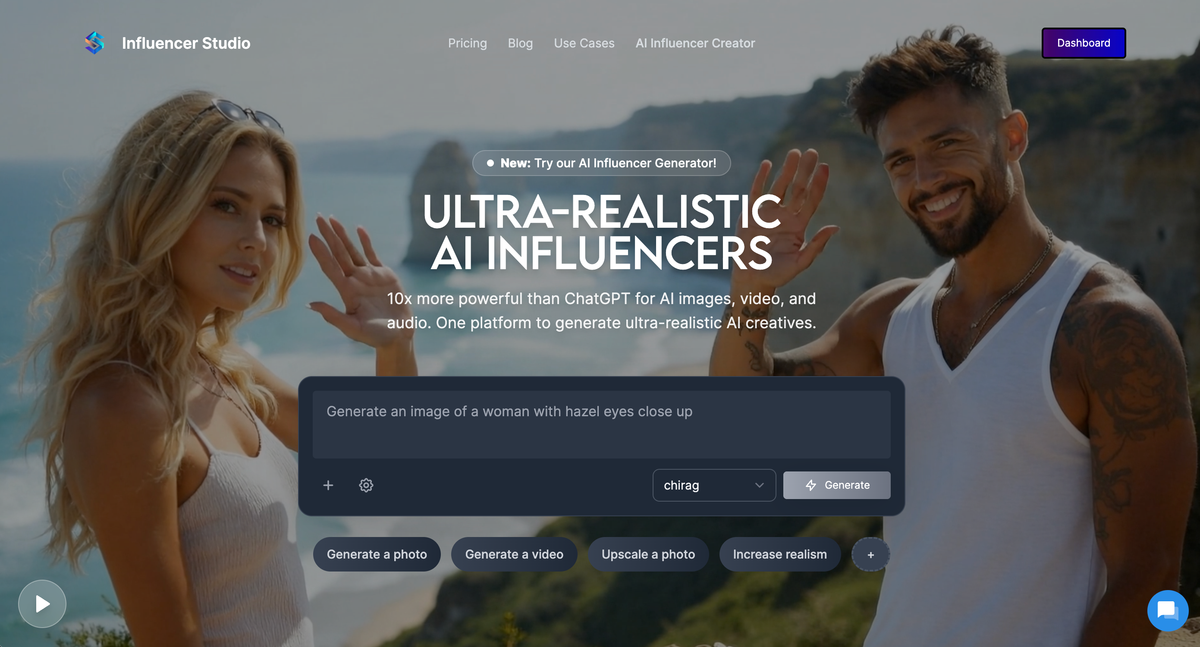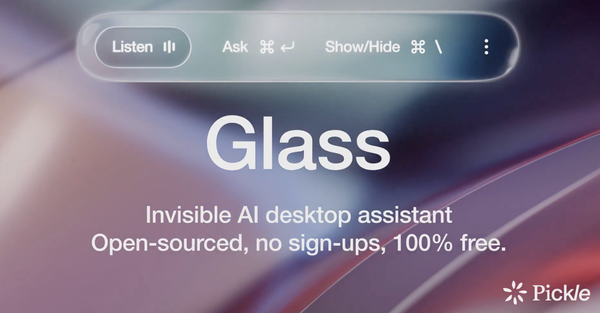The 10 BEST AI Influencer Generators (2026)

Looking for the most realistic, brandable AI influencers in 2026? Whether you're a creator, brand, startup, or marketing agency — AI influencer generators have made it possible to design, customize, and deploy virtual influencers in minutes.
Here are the top 10 platforms leading the space right now.
Influencer Studio Best Overall AI Influencer Generator
Influencer Studio - AI influencer generator
We also got an interview with co-founder Emily Tang.
Why it’s #1:
- Ultra-realistic AI faces and full-body influencer generation
- Customizable personalities, bios, and Instagram-ready content
- Video + image generation, LoRA training, and automated posting workflows
- Built for creators, agencies, and SaaS businesses
- Commercial-use rights and API available
InfluencerStudio is the most advanced end-to-end platform — generate an influencer, train it to match your brand aesthetic, and create consistent photos, ads, and stories on autopilot.
✅ Best for: Brands, entrepreneurs, SaaS founders, marketing agencies
Why it’s compelling
- Consistency engine: Upload a small set of photos, train a custom LoRA, and keep the same face and style across shoots and formats. That’s the #1 headache for “AI influencer” projects and this directly targets it. Influencer Studio
- End-to-end workflow: Image + video gen, editing, face swap, and UGC ad production in one platform—less glue code, fewer round-trips. Influencer Studio
Best for: Teams building a repeatable, brandable persona (or many) where visual continuity matters for sponsorships, catalog work, or always-on social.
Trade-offs: You’ll still need a posting/analytics layer (e.g., social schedulers, attribution) and a clear persona playbook—no platform can replace storytelling.
2) Captions AI
What it is: A full AI video studio with tools like AI Avatars, eye-contact correction, auto-subtitles, clip-finding, translation/dubbing, and quick editing. Captions also touts “AI twins” and large-scale availability across platforms.
Why it’s compelling
- Speed to publish: Record or upload, clean the takes (remove pauses, eye contact fix), translate/dub, and ship. For TikTok/Reels cadence, this is gold.
- AI avatars at scale: Good for spokesperson-style assets and localized content runs. Captions reports global availability and significant adoption.
Best for: Creators/brands who want to ship a lot of short-form video (multi-language) with minimal editing overhead.
Trade-offs: Avatars skew “talking-head.” For fashion/editorial stills or stylized photo shoots, pair with a photo-first tool.
3) SynthLife
What it is: An all-in-one create-grow-monetize platform specifically for virtual influencers. Positioning is both creator- and business-oriented.
Why it’s compelling
- Lifecycle mindset: Beyond generation, SynthLife markets growth and monetization primitives for running a virtual-influencer as a proper asset.
- Onboarding clarity: The site messaging and CTA flow are newbie-friendly—useful if you’re spinning up your first virtual persona.
Best for: Early teams that want a guided “business of virtual influencers” platform rather than a pile of creative tools.
Trade-offs: You’ll want to evaluate export options and how flexible the pipeline is if you later grow into heavier custom workflows.
4) APOB (Apob.ai)
What it is: A creator-facing tool for human-style AI influencers with video generation and consistent identity across multiple outputs. Content is framed for social traffic and monetization.
Why it’s compelling
- Video-forward: Smooth on-ramp to short-form, with messaging aimed at driving traffic across YouTube/TikTok/IG/Twitter.
- Consistency pitches: Users highlight stable looks over many renders—key for recognition and follow-through. (Anecdotal but useful to note.)
Best for: Solo creators and small shops who want to prototype an AI persona quickly and get it onto socials.
Trade-offs: Fewer “studio-grade” controls than big suites; vet licensing and commercial rights per use case.
5) HeyGen
What it is: One of the category leaders for AI avatars and influencer-style video at scale: script, customize, and generate lifelike spokespeople and digital twins.
Why it’s compelling
- Custom digital twins: Calibrate with a short video; get a realistic avatar of yourself/teammate for repeat content.
- Enterprise-ready throughput: Strong for brands that need lots of versions (languages, markets, products) without re-shoots.
Best for: Talking-head campaigns, tutorials, and product demos where voice + face carry the message and you need multi-language at scale.
Trade-offs: As with any avatar system, hyper-stylized fashion/editorial stills are not its core; pair with a still-image generator for lookbooks.
6) Influencer Farm
What it is: A platform to generate ultra-realistic AI influencers in seconds, including themed “virtual photoshoots,” outfits, and locations; supports images and video.
Why it’s compelling
- Photoshoot metaphors: Pick scenes (e.g., “Iceland,” “Weekend in Athens”), outfits, and get cohesive sets—useful for feed planning.
- 3-step build flow: Describe influencer → customize scenes → generate. A great way to spin campaign-specific content fast.
Best for: Fashion, travel, and lifestyle feed planning where varied backgrounds and looks are essential.
Trade-offs: Heavier brand control (exact garments, poses, props) may require iteration or additional editing.
7) Glambase
What it is: A creation + monetization platform for AI influencers, emphasizing ease and revenue outcomes (testimonials highlight IG growth/engagement).
Why it’s compelling
- Monetize-first framing: Not just looks—tools and guidance to engage and monetize audiences.
- Social proof: Creator stories and reviews focus on practical outcomes (posting cadences, results).
Best for: Builders who want a turnkey path to revenue (subs, sponsorships, fan interactions), not just pretty renders.
Trade-offs: Evaluate paywalls, rev-share, and audience-interaction mechanics to ensure they fit your brand model.
8) Virbo (Wondershare)
What it is: Wondershare’s AI video suite with an AI Influencer Generator, 350+ avatars, 400 voices, and ~80 languages—strong for templated production at volume.
Why it’s compelling
- Template-at-scale: Prebuilt avatars + large language/voice library; ideal for multi-SKU or multi-market video updates.
- Niche kits: Virbo even markets specialized “influencer” concepts (e.g., themed generators) for quick creative angles.
Best for: Product explainers, catalog drops, localized promos—anywhere you benefit from repeatable structures.
Trade-offs: House style leans “presenter.” For fashion-editorial stills, pair with an image-first tool.
9) D-ID
What it is: A pioneer in digital people/talking-head video with studio workflows and APIs. Frequently used for spokespersons, training, and creative characters.
Why it’s compelling
- Battle-tested talking heads: Good mouth-sync, easy pipelines for script-to-video, and enterprise-friendly integrations. (General positioning from product pages and ecosystem coverage.)
- API posture: Solid option if you’re building your own app around avatar video.
Best for: Programmatic generation of presenter videos, explainers, and character dialogue inside custom products.
Trade-offs: As with other avatar studios, it’s not built for stylized stills/fashion shoots—mix and match.
10) Jogg AI
What it is: A talking-avatar generator positioned for e-commerce explainers and short-form social; often listed among “AI influencer creator” tools for brands.
Why it’s compelling
- Product-centric: Turn a product page or brief into quick spokesperson videos. Handy for founders without on-camera talent.
Best for: Shop videos, UGC-style explainers, and quick tests across channels.
Trade-offs: More focused than full “virtual influencer businesses”—you’ll want separate persona tooling for large, character-driven brands.
Choosing the Right Stack (Quick Guide)
- You want a single, highly consistent fashion persona → Influencer Studio
- You need revenue features out of the box → Try Glambase.
- You’re shipping multi-language spokesperson content → HeyGen, Captions, or Virbo for fast dubbing/avatars and wide language coverage.
- You’re building your own app and need programmatic API - use Influencer Studio.
Reality Check: Ethics & Disclosure
AI-generated faces are powerful—and ripe for misuse. Recent reporting highlights deepfake scams and wellness grifts that weaponize avatar tech (often made with tools like HeyGen/Captions). If you deploy AI influencers commercially, disclose clearly and keep your claims grounded. Long-term trust beats short-term clicks.




